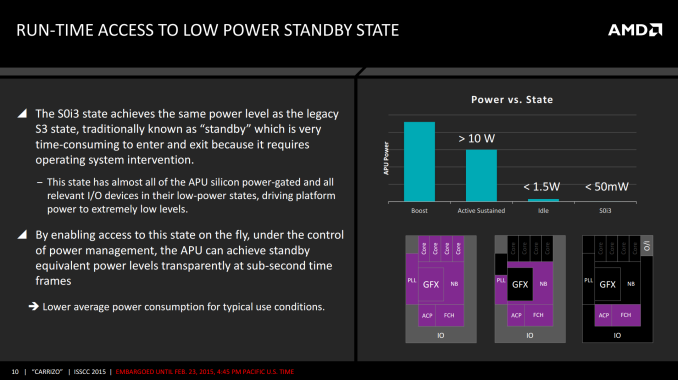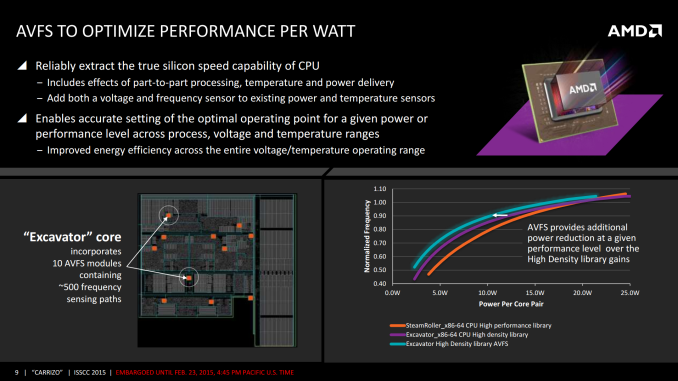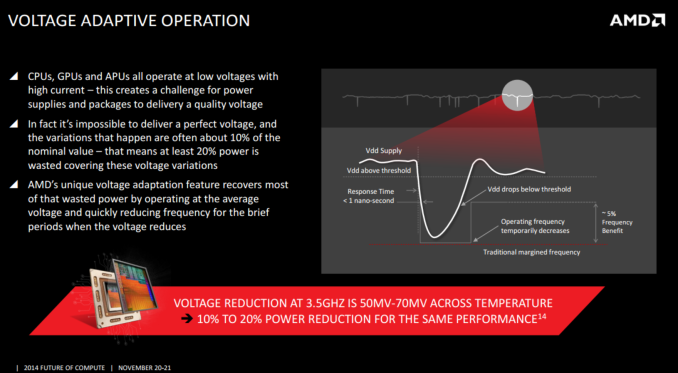AMD Launches Carrizo: The Laptop Leap of Efficiency and Architecture Updates
by Ian Cutress on June 2, 2015 9:00 PM ESTPower Saving and Power Consumption
When it comes to power, Carrizo features two/three technologies worth discussing. The first is the use of low power states, and the different frequency domains within the SoC. Previous designs had relatively few power planes, which left not as many chances for the SoC to power down areas not in use. Carrizo has ten power planes that can be controlled at run-time, allowing for what can be described as a dynamic race to sleep. This is bundled with access to the S0i3 power state, giving sub 50mW SoC power draw when in sleep and wake-up times under a second.
This is also combined with automated voltage/frequency sensors, of which an Excavator core has 10 each. These sensors take into consideration the instructions being processed, the temperature of the SoC, the quality of power delivery as well as the voltage and frequency at that point in order to relay information about how the system should adjust for the optimal power or performance point.
AMD states that this gives them the ability to adjust the frequency/power curve on a per-module basis further again to the right, providing another reduction in power or increase in frequency as required.
Next up for discussion is the voltage adaptive operation that was introduced back in Kaveri. I want to mention it here again because when it was first announced, I thought I understood it at a sufficient level in order to write about it. Well, having crossed another explanation of the feature by David Kanter, the reason for doing so clicked. I’m not going to steal his thunder, but I suggest you read his coverage to find out in more detail, but the concept is this:
When a processor does work, it draws power. The system has to be in a position to provide that power, and the system acts to restabilize the power while the processor is performing work. The work being done will cause the voltage across the processor to drop, to what we classically call Voltage Droop. As long as the droop does not cause the system to go below the minimum voltage required for operation, all is good. Voltage Droop works if the supply of power is consistent, although that cannot always be guaranteed – the CPU manufacturer does not have control over the quality of the motherboard, the power supply or the power conversion at hand. This causes a ripple in the quality of the power, and the CPU has to be able to cope with these ripples as these ripples, combined with a processor doing work, could cause the voltage to drop below the threshold.
The easiest way to cope is to put the voltage of the processor naturally higher, so it can withstand a bigger drop. This doesn’t work well in mobile, as more voltage results in a bigger power draw and a worse experience. There are other potential solutions which Kanter outlines in his piece.
AMD has tackled the problem is to get the processor to respond directly. When the voltage drops below a threshold value, the system will reduce the frequency and the voltage of the processor by around 5%, causing the work being done to slow down and not drain as much. At AMD’s Tech Day, they said this happens in as quickly as 3 cycles from detection, or in under a nanosecond. When the voltage drop is normalized (i.e. the power delivery is a more tolerable level), the frequency is cranked back up and work can continue at a normal rate.
Obviously the level of the threshold and the frequency drop will determine how much time is spent in this lower frequency state. We were told that with the settings used in Carrizo, the CPU hits this state less than 1% of the time, but it accounts for a sizeable chunk of overall average power reduction for a 3.5 GHz processor. This may sound odd, but it can make sense when you consider that the top 5% of the frequency is actually the most costly in terms of power than any other 5%. By removing that 5% extreme power draw, for a minimal performance loss (5% frequency loss for sub 1% of the time), it saves enough power to be worthwhile.













137 Comments
View All Comments
yankeeDDL - Wednesday, June 3, 2015 - link
If you think as gaming as hard-core gaming, latest and greatest titles, max settings, high res, then yes, I agree.But, as a father, I can tell you that there are tons of kids that are OK with "some" gaming and for whom the parents won't fork 1Kusd for a powerful gaming rig, and for which AMD really offers a price/performance ratio that cannot be compared.
FlushedBubblyJock - Tuesday, June 9, 2015 - link
having kids in usa is down down down, so not so much biz therebarleyguy - Thursday, June 4, 2015 - link
The marketing for this particular launch is specifically targeting players of MOBAs, such as League of Legends, DOTA2, and Starcraft. The active players of those 3 games is about 100 million people. You can argue that's not a majority of users, but AMD has never had a majority share of laptops, and 100 million people is a sizable market.I expect that AMD will make more direct appeals for that group of people, such as sponsoring tournaments, and generally trying to establish mindshare for laptops in that group.
I don't think targeting that particular niche market is a bad idea, personally.
Refuge - Thursday, June 4, 2015 - link
Their APU's can perform on those games very well, but also so can all of Intel's HD series graphics, at least every rendition I've ever seen.It won't be an easy crowd to win over. Even if the requirements for their sport only warrant a $300 computer, you know they are gamers and still want their supercomputers.
Magichands8 - Wednesday, June 3, 2015 - link
I agree with this. But it also doesn't make sense to me why they have. CPU's have been commodity devices for some time now and it makes no sense to me whatsoever that the average consumer would buy Intel when they can transparently get the very same performance for their needs with a much cheaper AMD processor. This, plus the fact that AMD does so well with essentially embedded systems (XBox, Playstation) even though they are 'AMD Inside' suggests to me that their struggle is largely due to marketing failures rather than technological ones.medi03 - Thursday, June 4, 2015 - link
Athlon 64th were outsold by Intel's Prescott that was:a) slower
b) consumed more power
c) more expensive
also because of "AMD's marketing failures" I guess...
FlushedBubblyJock - Tuesday, June 9, 2015 - link
no it's the skin that surrounds the amd heart - and that skin is cheap and ugly - that's how amd plays their cards... a low class dirt bucket cheap compile - so even if it could be made to look great and "feel very expensive and well constructed" - those creating AMD skin WON'T DO IT.FlushedBubblyJock - Tuesday, June 9, 2015 - link
Thinking again I will admit when browsing new laptops in person AMD GAMING ! is not something I can ever recall seeing ... it's very tough sometimes just to get the basic specs visible by the box stores....AS118 - Wednesday, June 3, 2015 - link
I don't ind 1366 x 768 on a smaller screen (14" and less for me) and think that AMD's performance on 900p and below's great. I also think that it's sad that more people don't know about them and how capable they are.Many casual customers who would want that extra gaming performance don't even know it exists on A8's and A10's.
AS118 - Saturday, June 6, 2015 - link
Yeah, I don't mind 1366 x 768 myself on smaller laptops, and gaming at that resolution is a thing with AMD APU's. Gaming performance on the A8 and especially A10 APU's is why I've been getting AMD Processors on Laptops for years.I don't need a lot of GPU oomph on my laptops, just needed the option to play casual games and not that hard to run stuff like WoW (well, before WoD at least) on the go.